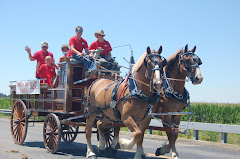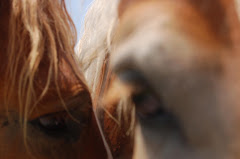Most horse owners are familiar with artificial insemination (AI). For those of you which are not, AI is big business in the equine industry. The last 20 years has seen a huge increase in the number of breed registries which allow artificial insemination. This blog will explain AI from the mare's perspective.
Artificial insemination is performed by depositing a sample of equine semen into the mare's reproductive tract or uterus. The semen can be either fresh, cooled or frozen. Semen that is classified as fresh is collected from the stallion and then inseminated into the mare within a short period of time on the same farm. For the most part, cooled and frozen semen is transported from the collection farm to another location. This allows mare owners to breed their mares to stallions located in a different part of the country or countries. Semen that is cooled is also collected from the stallion but then processed and packaged in special containers to cool the semen at a specific rate.
Here's two pictures of shipping containers for cooled semen. The blue container is called an Equitainer and is shown with the special coolant can. These containers are meant to be reused.

This is a picture of a disposable container which utilized frozen packs to chill the semen.

This is a picture of the inside of a disposable shipper container with the semen packaged and sent in a syringe.
 Cooled semen is meant to be inseminated in the mare within 24-48 hours of collection. Cooled semen is typically either sent via an overnight carrier (UPS, Fedex...etc) or placed on an airline as a cargo shipment. Transporting semen via an airline is typically called "counter to counter" shipments and this method allows mare owners to receive semen the same day and on the weekends. Semen that is frozen is collected from stallions, processed and then frozen. Theoretically, frozen semen can be stored in a frozen state indefinately. Because of this, a mare could be bred with frozen semen after the stallion has died.
Cooled semen is meant to be inseminated in the mare within 24-48 hours of collection. Cooled semen is typically either sent via an overnight carrier (UPS, Fedex...etc) or placed on an airline as a cargo shipment. Transporting semen via an airline is typically called "counter to counter" shipments and this method allows mare owners to receive semen the same day and on the weekends. Semen that is frozen is collected from stallions, processed and then frozen. Theoretically, frozen semen can be stored in a frozen state indefinately. Because of this, a mare could be bred with frozen semen after the stallion has died.
Breeding a mare with cooled, transported semen (CTS)
The key to breeding a mare with CTS is the timing of the breeding. Ask any experienced reproductive veterinarian and they will tell you that the most successful veterinarians develop a keen sense or intuition. I guess what I'm saying is breeding mares is really an "art". You must use science and technology to be successful but without a good "feel" for how a mare cycles, all the science and technology in the world will not produce a pregnancy. There are several factors or signs to consider when breeding a mare with CTS. However, to avoid this blog sounding like a class in equine reproductive physiology, I will just explain the follicle development. Ideally, the semen is deposited into the mare's reproductive tract prior to ovulation. The closer the mare is bred to ovulation the better. When a mare is in estrus or heat, she develops a follicle which contains the egg. As the follicle matures or ripens, it becomes larger and softer. So, the ideal time to breed a mare is when she has a large, soft follicle....just before it ovulates and releases the egg into her oviduct. To determine the size and maturity of the follicle, the reproductive tract of the mare is "palpated" (to palpate means to touch or feel). Usually when a mare is palpted an ultrasound is used to actually view the follicle. The follicle can then be measured and recorded.
Here's a picture of one of our portable ultrasounds. This is the same ultrasound we use for pregnancy determination in mares.
 This is a great picture of a large follicle. The round, black structure on the ultrasound screen is the follicle. This follicle measure ~49mm.....a good size for breeding.
This is a great picture of a large follicle. The round, black structure on the ultrasound screen is the follicle. This follicle measure ~49mm.....a good size for breeding.
 Ultrasounding or sonogramming or palpating a mare
Ultrasounding or sonogramming or palpating a mare

Every other day or daily palpations/sonograms begin when a mare first shows signs of heat. Typically, I will order semen when a mare has a 35mm-40mm follicle......depending on the mare, breed of mare and availability of semen. The semen is ordered and shipped either overnight or on a airplane. I will usually give the mare an injection of an ovulatory medication to ensure she ovulates when I want her to.....which is hopefully 12-24 hours after she is bred.
The picture below shows the supplies used to inseminate a mare. Sterile OB pipette, sleeve and lubricant. If the semen was not shipped in a syringe, it is transferred to a syringe for insemination.
 Inseminating a mare.
Inseminating a mare. 
 After the mare is inseminated, I save a small sample of the semen to evaluate under a microscope. The two main criteria used to evaluate cooled semen are total sperm count and sperm motility. The recommended total count for breeding a mare with cooled, transported semen in 1 billion spermatozoa. Hopefully, the breeding farm collecting the stallion will send the sperm count data with the sample. Just as important or more so, though, is the sperm motility. Motility is defined as forward, progressive movement of a sperm cell. In other words, it does no good for sperm to be circling or going backwards. These sperm are not healthy and are infertile. we like to see motility of greater than 50% with cooled, transported semen. For evaluating semen, we have a video microscope which has a small screen for viewing the sperm. This type of microscope allows better determination of motility plus clients can see what we are seeing when evaluating a semen sample. We love this piece of equipment. And while you can certainly use a traditional microscope for evaluating semen, years ago we splurged and bought this "toy"!
After the mare is inseminated, I save a small sample of the semen to evaluate under a microscope. The two main criteria used to evaluate cooled semen are total sperm count and sperm motility. The recommended total count for breeding a mare with cooled, transported semen in 1 billion spermatozoa. Hopefully, the breeding farm collecting the stallion will send the sperm count data with the sample. Just as important or more so, though, is the sperm motility. Motility is defined as forward, progressive movement of a sperm cell. In other words, it does no good for sperm to be circling or going backwards. These sperm are not healthy and are infertile. we like to see motility of greater than 50% with cooled, transported semen. For evaluating semen, we have a video microscope which has a small screen for viewing the sperm. This type of microscope allows better determination of motility plus clients can see what we are seeing when evaluating a semen sample. We love this piece of equipment. And while you can certainly use a traditional microscope for evaluating semen, years ago we splurged and bought this "toy"!
Videomicroscope. The semen sample is placed on a slide which is placed on the microscope stage which is the blue box-like unit on the right. The sperm cells are seen on the screen as white dots or flecks. And voila'....here's a video of live, cooled, transported semen received via UPS from Texas at 24 hours old. This is a good sample of cooled, transported semen....(and one of the main reasons I wrote this blog.....I videoed this sample using my Flip video recorder while the sample was on the videomicroscope......isn't technology grand!!)
And voila'....here's a video of live, cooled, transported semen received via UPS from Texas at 24 hours old. This is a good sample of cooled, transported semen....(and one of the main reasons I wrote this blog.....I videoed this sample using my Flip video recorder while the sample was on the videomicroscope......isn't technology grand!!)































